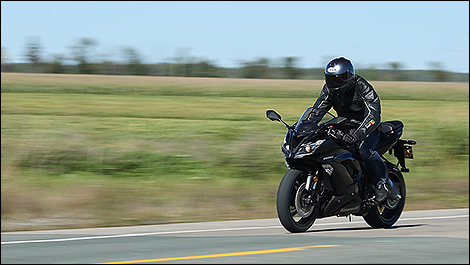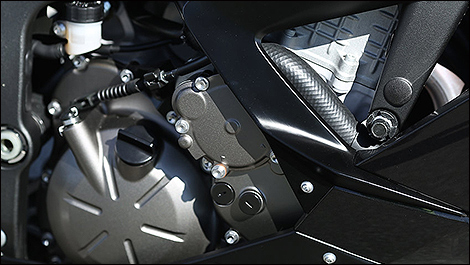The
2013 Kawasaki Ninja ZX-6R ABS marks a return to the beloved 636 cc engine. While not completely new, this superbike boasts a fair share of upgrades, especially in the electronics department.
Derived from the 2009-2012 Ninja ZX-6R (599 cc), the inline 4-cylinder gained 37 cc, yet its outer dimensions are virtually unchanged thanks to shorter connecting rods that make up for the longer piston stroke (from 42.5 to 45.1mm). This alone increases output by 3 horsepower, while the ram-air intake adds another six for a total of 137 hp.
The smooth and sharp transmission of the 2013 Kawasaki Ninja ZX-6R ABS gets a shorter first gear that makes low-speed riding easier, since you're not constantly relying on the clutch to stay balanced. Speaking of which, there's a new, high-tech FCC clutch system with assist and slipper functions that makes downshifts smoother and safer.
KTRC, KIBS FTW!
The 2013 Kawasaki Ninja ZX-6R ABS becomes the first 600 cc Japanese supersport ever (and second in the world after the
MV Agusta F3) to offer electronic riding aids. The new Kawasaki Traction Control (KTRC) system offers three different modes that cover a wide range of situations:
- Mode 1 is tuned to maximize acceleration on the track, like the Ninja ZX-10R S-KTRC system;
- Mode 2 is tuned to help provide a balance of performance with minimal wheel slip;
- Mode 3 prioritizes slip elimination, similar to the Concours14 ABS sport touring KTRC system, for enhanced rider confidence in mixed or slippery conditions.
The 2013 Kawasaki Ninja ZX-6R ABS also features the first intelligent antilock braking system (KIBS) in its class. Developed through a partnership with Bosch, it monitors front and rear wheel speed, front calliper hydraulic pressure, and data from the engine’s ECU to stabilize the machine and produce better, safer decelerations.
To learn more about these cutting-edge technologies, please read
Kawasaki S-KTRC and KIBS explained, which followed the introduction of the 2011 Ninja ZX-10R.
 |
| The 2013 Kawasaki Ninja ZX-6R ABS becomes the first 600 cc Japanese superbike ever (and second in the world after the MV Agusta F3) to offer electronic riding aids. (Photo: Philippe Champoux) |
Evolving to achieve a better compromise
Similar to the engine, the chassis of the 2013 Kawasaki Ninja ZX-6R ABS is derived from the 2009-2012 model. Upgrades include:
- Steeper rake angle (from 24 to 23.5 degrees);
- New Separate Function - Big Piston fork (SFF-BP), with dedicated preload adjustability in the left tube and dedicated damping pistons and adjustability in the right tube;
- Increased rear suspension travel (+25mm);
- Kawasaki's first monoblock callipers (90g lighter than the old ones).
The track-oriented ergonomics of the 2013 Kawasaki Ninja ZX-6R ABS are surprisingly well-suited for the road. The riding position feels quite sporty, yet natural, so you quickly get used to it. My only complaint is the rather large tank (which doesn't even hold more fuel than the outgoing model's due to a bigger air box).
 |
| The track-oriented ergonomics of the 2013 Kawasaki Ninja ZX-6R ABS are surprisingly well suited for the road. (Photo: Philippe Champoux) |
This bike doesn't kid around
The transmission and clutch both work like a charm. I could say the same thing about the engine, which displays plenty of grunt at medium revs. While the power edge versus other 600 cc models can be felt between 5,500 and 7,000 rpm, the 2013 Kawasaki Ninja ZX-6R ABS gets really serious from 8,000 rpm and gives its best all the way to the 16,000 rpm redline.
The extra output from the larger displacement is immediately felt on the road, with a quicker response and surprising surges for such a small block. Like any self-respecting Kawasaki superbike, this one sprints and screams without any signs of fatigue at higher revs. What a treat!
The 2013 Kawasaki Ninja ZX-6R's frame is neutral, agile through S-turns, and just stable enough when you pick up speed. The suspension does a great job overall, preserving some form of ride quality by soaking up road imperfections and controlling load changes.
The new braking system of the 2013 Kawasaki Ninja ZX-6R ABS shows superb power, and the ABS must be commended for its precise and discreet nature. KTRC proves as effective and transparent as it does on the
Ninja ZX-10R. In Mode 1, it will only step in to correct a major mistake by the rider. Its action is so seamless that you need to look down on the KTRC indicator after a slight rear-wheel skid to see if it actually came into play.
 |
| The transmission and clutch both work like a charm. I could say the same thing about the engine, which displays plenty of grunt at medium revs. (Photo: Philippe Champoux) |
Bottom line
In my opinion, the revised 2013 Kawasaki Ninja ZX-6R ABS edges the radical
Triumph Daytona 675R and
Yamaha YZF-R6 when it comes to hitting the road. It offers a great compromise thanks to an exciting engine size and more comfortable suspension and riding position. Of course, its main attribute is a comprehensive, state-of-the-art electronic aid package that takes performance and safety to unprecedented levels.
Now, let's see how it stacks up on a track...
Pros
- Sharp, stable frame
- Orgasmic engine
- Remarkably effective electronics
- Superb transmission and clutch
- Decent on the road
Cons
- Weight
- Cumbersome fuel tank
- Some dull-looking plastics

